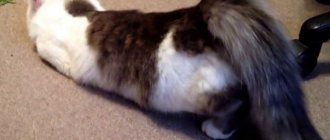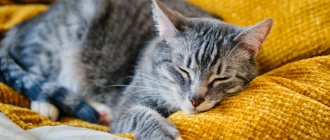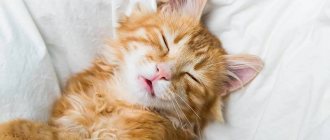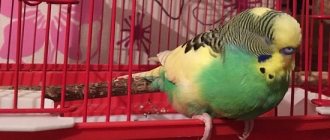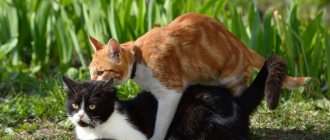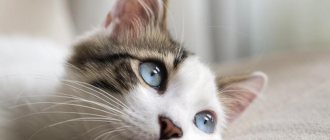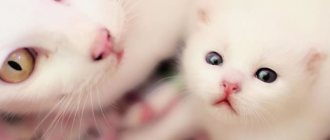Perhaps there is not a single indifferent person who would not be touched by the purring of a cat. It is this that gives the coziness that is so characteristic of cats. This contented, purring creature attracts mysterious, fascinated glances. Some owners suggest that in this way cats tell them bedtime stories and share their daytime adventures. In our article we will try to reveal in more detail such questions as why cats purr, and what physiological reasons allow them to do this.
Mechanism of sound occurrence
Why are the mechanics of a cat's purr still so poorly understood? The fact is that it is possible to determine for certain what and how cats purr only by dissection. But, of course, the dead don’t sing any “songs.” And modern diagnostic methods do not allow us to determine the origin of sounds.
It is known that there is no special organ for chirping sounds. This process definitely involves the vocal cords, the lungs, since “mur” sounds rhythmically, on inhalation and exhalation, and, possibly, the diaphragmatic and intercostal muscles. And - absolutely - the brain.
A cat's purring is a complex process that involves the lungs, muscles and brain.
Most researchers believe that cats purr through their throats. The vocal cords contract and the sound passing through them vibrates with each inhalation and exhalation. But what makes a cat do this? Question for neurophysiology. The “motor” is started by a mechanism in the brain.
Interesting fact: the comparison of a purring cat with a tractor is not accidental. At idle the car produces the same 15–150 Hz. Owners note that female cats purr louder than male cats.
There are alternative theories of the origin of uterine sounds:
- This is the sound of blood moving through the inferior vena cava, which carries venous blood to the heart.
- This is what the hyoid bones do.
- There are false vocal cords that are responsible only for these sounds.
- It was previously believed that vibrating sounds originated from the abdomen. But anyone who has petted a cat knows that this is not the case.
For now, the neurophysiological theory prevails: the need to vocalize breathing arises in the brain, and it already gives the command to the vocal cords. We hope that scientists will soon test the hypothesis and the age-old mystery will be revealed. In the meantime, let's figure out what causes the cat's brain to signal to the ligaments.
Most often, cats purr in a relaxed state, for example, on the owner's lap.
How sound is produced
There is a common misconception that cats create a purring sound through their nose. In fact, the muscles of the larynx are involved in the production of sound.
But the initial role in the formation of purring is given to the brain - from there signals come to the muscles of the larynx, causing them to contract, which sets the vocal cords in motion.
The brain's involvement in the process of creating sound explains why cats purr for a reason rather than as a reflex.
For example, when cats see something interesting nearby - food, a favorite toy - signals from the senses stimulate parts of the brain to activate the muscles of the larynx and a purring sound is produced.
Purring is possible because cats have hyoid bones between the base of their skull and the base of their tongue. The movements of the vocal cords create vibrations that are transferred to these parts of the skeleton, and then spread throughout the entire body of the individual.
Large cats do not have thin hyoid bones, so they cannot purr. In this place they have large bones covered with cartilaginous tissue, so lions and tigers are able to roar, which cats cannot do.
What does a cat's purring mean?
Previously, it was believed that this is how animals communicate with each other and humans when they are stroked. However, “mur-mur-mur” is not only a means of communication and a way to express pleasure.
Method of communication
Kittens begin to purr already in the first days after birth. This is how they help mom find herself and feed her. With a person, everything works about the same. Animals wake people up, butt and purr loudly in the morning, especially if they spend the night in another room. “Good morning, master! It’s time to get up and feed me.” If your pet loudly “sings songs” in the kitchen (or where you usually feed your pet) and curls under your feet, meowing periodically, this is a direct hint of a desire to snack.
Surely you have noticed more than once that pets greet you stormily from work. At this moment, you can also hear a joyful “mrrr”.
Purring, the cat greets its human.
In relation to relatives, everything works exactly the same: a quiet sound indicates location. He warns others about a benevolent and good-natured attitude. This is also how animals encourage each other. Some scientists have noticed that wounded cats lie down next to each other.
Expression of pleasure
A satisfied cat - what could be more pleasant for the owner? Pets can actually express pleasure and even gratitude from tasty food, a secluded bed and warmth. Many pets love affection, and with the help of purring they express pleasure from stroking and scratching.
In combination with paw stomping, purring indicates peace and love. This means that your pet completely trusts you, is happy and feels as calm as she does next to her mother. After all, kittens’ little paws make “massage” movements to get more milk. Apparently, the memory remains with the animal forever, and pops up in moments of good mood. And besides, in this way the cat “marks” the owner.
Connection with nutrition
Remember that a kitten purrs so that the cat notices and feeds it? Echoes of this mechanism can be seen in the fact that many animals rumble when they eat. Perhaps from pleasure. Especially if it is SUPERPET - a species-typical food for cats and dogs according to the BARF system, developed by veterinarians and nutritionists. It replicates the diet of predators in nature: 98% consists of raw meat without heat treatment, flavor enhancers and preservatives. Biologically appropriate nutrition normalizes digestion, prevents urolithiasis, kidney disease and other ailments. And how delicious it is! Pets can only purr with pleasure.
Food for adult cats and kittens
Start shopping
Stress and pain
Cats begin to make purring sounds in different situations. It can be very stressful - right after having to run away from the dog. Or weak - when examining a new room. By purring, pets calm not only humans, but also themselves. Rhythmic sounds are a great way to relax.
There is a hypothesis that purring animals heal themselves. Vibration frequency from 20 to 150 Hz helps restore tissue, including bone, grow muscles, repair tendons and ease breathing. In their natural environment, animals have to sit in ambush for a long time when hunting and jump quickly, so it is important to maintain bone tissue in order.
Felines often purr when they fall asleep. It is possible that a large amount of sleep is also associated with the restoration of the body - up to 20 hours a day.
Loud purring for no apparent reason can be a signal to the owner that the cat is in pain. Especially if she sits with her eyes closed and her mustache drooping. Be careful: these animals endure pain until the last moment and hide their symptoms.
If a cat purrs in a tense position without closing its eyes, it is unlikely that it is feeling well at that moment.
During childbirth, cats also purr, helping themselves to overcome pain. Unfortunately, even before death, many of them make such sounds. Purring is very connected with physiological processes: appearing in the first days of life, it remains with the cat until the very last moments.
It is important to note that all cats are different, and they also vocalize their emotions differently. Some of them do not purr at all, while others trill constantly. And all these are variants of the norm. You can understand what your pet wants at the moment by her body language. A relaxed posture indicates pleasure, a tense one indicates that she wants something from you. An excited purr near a bowl is very different from what you hear when a furry dog curls up next to you.
When she gets what she wants, the purring stops. Think about the situations in which this happens and what the animal wants to tell you. Develop your powers of observation and you will be able to better understand your four-legged companion.
How does purring affect a cat's body?
Sometimes a healthy cat purrs next to a sick one, and this happens for a reason. From the outside it may seem that a purring cat is happy with the presence of a relative, but British scientists have proposed a version of purr therapy. Firstly, the monotonous sound is soothing. Secondly, the vibration produced by purring is similar to a massage. In this case, we are talking about a therapeutic effect on internal organs. In addition, purring increases the cat's vitality and improves its mood.
By purring, a cat can “treat” not only itself, but also its relatives
Indeed, if you watch a cat, you can see how it licks its wound and purrs. Saliva has a disinfecting effect, and purring acts as an ultrasound and anti-stress. Purring cats are healthier, calmer and friendlier.
Video: purring - a lullaby for a kitten
Do big cats purr?
We have said more than once that the anatomy of a domestic cat is no different from the structure of a wild one. From a structural point of view, the gastrointestinal tract has not changed over millennia of evolution. What about neurophysiology and psychology?
Small cats - caracals, lynxes, cheetahs - purr like our domesticated pets. Although, of course, more often they hiss. Leopards, lions, panthers and tigers do not purr in the usual sense - they rather roar and make bass sounds. Their purr is more like a roar. But predators definitely use these techniques to communicate, when consuming food and expressing pleasure. There are videos online of cheetahs, tigers and pumas purring.
Why your cat doesn't purr and what to do about it
Is it possible to make a cat purr? No, especially if she is not naturally inclined to do this. And that's okay: not everyone feels the need to express emotions by purring. There are even breeds that are not inclined to turn on their “engines” - Ragdolls and Devon Rex. Here, again, there are exceptions.
Getting a purr to do anything is very difficult in general, and with purring and other ways of expressing emotions it is even more difficult. This partly explains the impossibility of accurately diagnosing the mechanics of the appearance of iridescent sounds in predators. Nobody wants to purr in an MRI machine or during an ultrasound.
Sometimes this “insensitivity” is related to previous negative experiences. If the cat has been with bad owners or on the street, it may simply be afraid to show emotions by purring. You can try to help your cat make the desired sounds. Play with her, caress her, introduce treats into her diet (always natural) and demonstrate by your behavior that you are a safe person.
What is purring like?
Purrs vary in volume and duration of sound. If a cat makes a loud noise, it could signal problems or negative emotions, such as being unhappy or scared.
Loud and short-lived purring can be a sign of hunger. If the loud purring does not stop for a long time, there is a possibility that the animal is in pain.
When a cat is relaxed and calm, it makes a quiet and soft sound. In this case, the purring lasts a long time.
The benefits of a cat's purring for humans
Our smaller furry brothers are real doctors. There is even feline therapy - treatment by communicating with cats. Pet owners cope better with stress, are less likely to become depressed, are more sociable and, in general, are healthier than people without pets. Why is purring useful?
Cats are furry physiotherapists. At a frequency of 25-50 Hz, bone tissue responds to purring, and at 100 Hz, skin and soft tissues respond. It's not as crazy as it may seem: the body's tissues respond to pressure by becoming stronger. Scientists even propose using this property of vibration for astronauts so that their bones do not lose their density in zero gravity.
A purring cat pleases the human heart. This means that having a pet in the home reduces the likelihood of having a stroke by a third. “Pur-mur-mur” is a kind of white noise, to which the owner calms down and falls asleep more easily.
Thus, not all purring kittens and cats are happy with their situation. A purring pet can feel both joy and pain. This amazing means of communication allows animals to communicate with each other and get what they want from humans. If a cat likes food or, conversely, is hungry, it will purr. This is done by domestic purrs, cheetahs, and pumas. But if your pet does not want to purr, this is also not a problem, and you can do nothing about it.
Cat purring - real sound therapy
We have already mentioned that cats often lie down on the owner’s sore spot and begin to purr. An animal can, for example, lie on the owner’s legs if they are “whining” about the weather. Or even lie on your head when the owner is tormented by a migraine. What does this mean, can pets really heal? It turns out that the purring of cats is therapeutic sound therapy.
Photo: Scottish Fold kitten | Dreamstime.com
A measured, quiet sound calms frayed nerves no worse than the sound of rain or the sound of a babbling stream. Felinologists believe that cats, with the help of special rumbling sounds, can treat the following ailments:
- Bone fractures, joint and muscle pain;
- Nervous disorders (depression, stress);
- Reduced immunity;
- Arterial hypertension;
- Diseases of the heart and blood vessels;
- Various inflammatory processes;
- Diseases of the stomach and/or intestines;
- Respiratory ailments.
Even though the sounds of rumbling help relieve, for example, joint pain or lower blood pressure, such sound therapy cannot be considered a full-fledged treatment; you will still need the help of a doctor. However, a cat's purring fights well against the same fatigue and nervousness.
